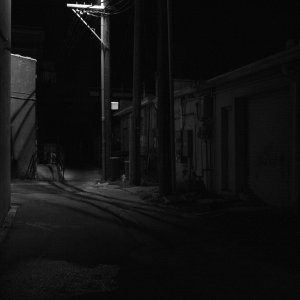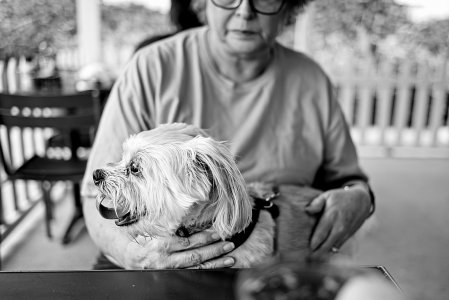Gatorguy
Member
I see the images in monochrome, since my settings for preview are also set to the same.They have really nice tonality. The alley scene is noisier than I would expect for the ISO but I haven’t really used the KiMono in that environment so my only comparison is with the Leica Monochroms. Removing the microlenses in a conversion does decrease pixel fill, that might be part of it.
With the original firmware and modified sensor, what does the screen show you when you review photos in camera?
As for the noise, all those shots were opened in On1 Photo Raw. For giggles I reopened in Adobe Camera Raw this morning, and for extremely low light/high ISO Adobe does much better. That example is posted below. For the others I preferred On1, but on import it does handle raw levels differently than Adobe.
I didn't use Monochrome2dng on these because I didn't see a need to, but I may run that particular image thru it this evening just to compare the results.
Attachments
Zuiko-logist
Well-known
The is image looks very good.
vitaly66
slightly tilted
Very cool to see your images here, just what we needed!I'm VERY pleased with the file quality. The conversion was done by a member of Pentaxforums, who previously did a K3 for me. Turnaround was roughly three weeks, discounting the shipping time involved in sending my K1 to him and the return time. IIRC shipping added about another 3 weeks in total.
Did you have your K1 conversion done by that fellow in Lithuania?
Home Page
Website dedicated to information about monochrome conversion of Ricoh GR, Pentax and Nikon sensors
The sample images he has on display are brilliant.
Gatorguy
Member
It is. He goes by Medex for simplicity and I highly recommend him.Very cool to see your images here, just what we needed!
Did you have your K1 conversion done by that fellow in Lithuania?
Home Page
Website dedicated to information about monochrome conversion of Ricoh GR, Pentax and Nikon sensorsmonomod.eu
The sample images he has on display are brilliant.
Gatorguy
Member
vitaly66
slightly tilted
I have a theory -- so far untested speculation -- that the Monochrome will make an excellent device for getting top-quality "scans" from black & white negatives.
Your thoughts?
Your thoughts?
Zuiko-logist
Well-known
Would be interested to see that!
Gatorguy
Member
I've read threads where fellow film photogs use their digital camera as a "scanner" for digitizing images. My K1 Mono is roughly equivalent to having an 80MP sensor, more resolution than typically available, so it might be worth my time to read up on the process and give it a try.I have a theory -- so far untested speculation -- that the Monochrome will make an excellent device for getting top-quality "scans" from black & white negatives.
Your thoughts?
Out to Lunch
Menteur
I've been looking at this gadget. You'll need a macro lens. Cheers, OtLfilm photogs use their digital camera as a "scanner"
shawn
Mentor
How do you figure 80mp? When a sensor with a color filter is converted to B&W it still uses all the pixels. If you use a high resolution sensor shift mode every pixel ends up being recorded, in all three colors, and you typically gain more DR too. Depending upon the camera this might also increase overall resolution or it might not. I think the K1 stays at 36 megapixels when in this mode but with full color info at every pixel position. My S1R increases resolution to 187 megapixels in high resolution mode.I've read threads where fellow film photogs use their digital camera as a "scanner" for digitizing images. My K1 Mono is roughly equivalent to having an 80MP sensor, more resolution than typically available, so it might be worth my time to read up on the process and give it a try.
'Scanning' with a camera works very well if you have a good setup and it is dramatically faster than scanning on a flat bed or with a film scanner. Much higher resolution too. The two biggest things are making sure the negative and camera are square to each other and that no external light can get between the two. I 3d printed 35 and 120mm film holders and a lens/camera holder to hold the lens the proper distance away. Takes a minute or two to setup and I can scan an entire roll in a couple of minutes.
This is the 120 setup. Lens is the proper distance so negative height uses the entire height of the sensor. For 6x12,6x17 and 6x24 I just take multiple shots and stitch them together.
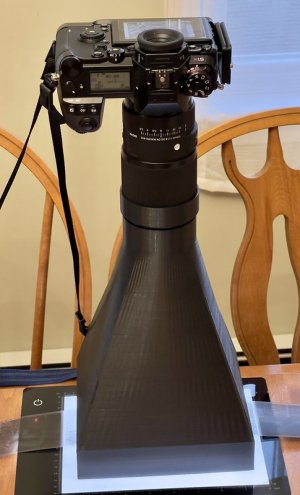
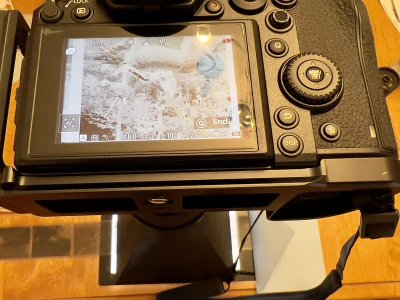
Gatorguy
Member
The K1, once debayered, now has all 36.4 million pixels recording light tone (luminance values) instead of split between red/blue/green/greens, similar to your S1R high-resolution mode. If you debayer your Panny it doesn't benefit further from high-resolution mode since all the pixels would already be recording the same type of luminance data without color interpolation. A debayered K-1II, which also offers high-resolution pixel shift ala' your S1R, won't benefit from the feature once monochrome converted either. That's why I converted a K-1 and not a super-res capable K-1II I also had available (still do). It's also why, if it's mission-critical, I use Monochrome2Dng before opening my converted sensor K1 images in my favorite raw converter software to maintain all that juicy light data.How do you figure 80mp? When a sensor with a color filter is converted to B&W it still uses all the pixels. If you use a high resolution sensor shift mode every pixel ends up being recorded, in all three colors, and you typically gain more DR too. Depending upon the camera this might also increase overall resolution or it might not. I think the K1 stays at 36 megapixels when in this mode but with full color info at every pixel position. My S1R increases resolution to 187 megapixels in high resolution mode.
'Scanning' with a camera works very well if you have a good setup and it is dramatically faster than scanning on a flat bed or with a film scanner. Much higher resolution too. The two biggest things are making sure the negative and camera are square to each other and that no external light can get between the two. I 3d printed 35 and 120mm film holders and a lens/camera holder to hold the lens the proper distance away. Takes a minute or two to setup and I can scan an entire roll in a couple of minutes.
This is the 120 setup. Lens is the proper distance so negative height uses the entire height of the sensor. For 6x12,6x17 and 6x24 I just take multiple shots and stitch them together.
View attachment 4836987
View attachment 4836988
The person who did my conversion, one of dozens, determines the effective spacial resolution at around 88mp IIRC after debayering. I can inquire to be more precise, but it's not actually that important to me. By my rough calculation of red/green/blue pixels but not doubling up on the green, I think it's closer to 100 or so, but I think it's safe to say somewhere between 80 and 100, and a much higher sensitivity to luminance.
Oh, and that's a cool, clean, and straightforward scanning setup you have! I plan to spend a little time duplicating the process, even if not the equipment. It had never occurred to me to use the camera for black and white scans. Thanks for that image.
Last edited:
Freakscene
Obscure member
If you measure the improvement in resolution, you get around a third increase at best, but copying negatives is a good example of where you can maximise the output. Tonality is hard to measure, but I got the nicest black and white film ‘scans’ since the Leaf 45 from the M11M with BEOON and a high resolution copy lens.The K1, once debayered, now has all 36.4 million pixels recording light tone (luminance values) instead of split between red/blue/green/greens, similar to your S1R high-resolution mode. If you debayer your Panny it doesn't benefit further from high-resolution mode since all the pixels would already be recording the same type of luminance data without color interpolation. A debayered K-1II, which also offers high-resolution pixel shift ala' your S1R, won't benefit from the feature once monochrome converted either. That's why I converted a K-1 and not a super-res capable K-1II I also had available (still do). It's also why, if it's mission-critical, I use Monochrome2Dng before opening my converted sensor K1 images in my favorite raw converter software to maintain all that juicy light data.
The person who did my conversion, one of dozens, determines the effective spacial resolution at around 88mp IIRC after debayering. I can inquire to be more precise, but it's not actually that important to me. By my rough calculation of red/green/blue pixels but not doubling up on the green, I think it's closer to 100 or so, but I think it's safe to say somewhere between 80 and 100, and a much higher sensitivity to luminance.
Oh, and that's a cool, clean, and straightforward scanning setup you have! I plan to spend a little time duplicating the process, even if not the equipment. It had never occurred to me to use the camera for black and white scans. Thanks for that image.
Last edited:
shawn
Mentor
Your spatial resolution is going to be 36 megapixels. You didn't gain resolution, you got rid of potential artifacts from demosaicing.
Take a shot of something on your mono K1 then take the same shot on a color camera with 2x the megapixels. The high resolution camera is going to have more detail along with potentially some artifacts from demosaicing. You can see this here. Compare the M246 Monochrome vs the S1R (Panny about 2x the resolution of the Monochrom). There is some moire on the Panny image in regular resolution color mode but it still has more detail than the M246 monochrome. Download the RAW files and convert the S1R to B&W and the moire is gone and it clearly is more detailed than the M246 Monochrome. (Monochrom on left, S1R on right)
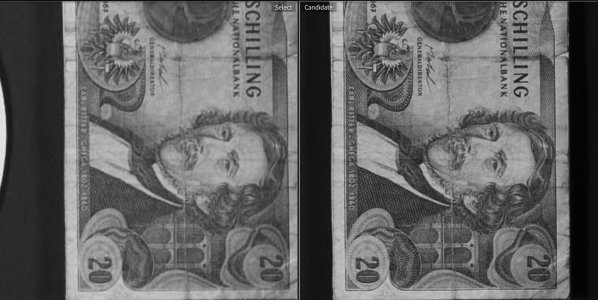
Converted to B&W the S1R is pretty comparable to the M11 Monochrom. The S1R in high resolution mode is considerably more detailed and doesn't have the moire issues in color mode since every pixel has every color.
Take a shot of something on your mono K1 then take the same shot on a color camera with 2x the megapixels. The high resolution camera is going to have more detail along with potentially some artifacts from demosaicing. You can see this here. Compare the M246 Monochrome vs the S1R (Panny about 2x the resolution of the Monochrom). There is some moire on the Panny image in regular resolution color mode but it still has more detail than the M246 monochrome. Download the RAW files and convert the S1R to B&W and the moire is gone and it clearly is more detailed than the M246 Monochrome. (Monochrom on left, S1R on right)

Converted to B&W the S1R is pretty comparable to the M11 Monochrom. The S1R in high resolution mode is considerably more detailed and doesn't have the moire issues in color mode since every pixel has every color.
Gatorguy
Member
Thanks for the example.Your spatial resolution is going to be 36 megapixels. You didn't gain resolution, you got rid of potential artifacts from demosaicing.
Take a shot of something on your mono K1 then take the same shot on a color camera with 2x the megapixels. The high resolution camera is going to have more detail along with potentially some artifacts from demosaicing. You can see this here. Compare the M246 Monochrome vs the S1R (Panny about 2x the resolution of the Monochrom). There is some moire on the Panny image in regular resolution color mode but it still has more detail than the M246 monochrome. Download the RAW files and convert the S1R to B&W and the moire is gone and it clearly is more detailed than the M246 Monochrome. (Monochrom on left, S1R on right)
View attachment 4836994
Converted to B&W the S1R is pretty comparable to the M11 Monochrom. The S1R in high resolution mode is considerably more detailed and doesn't have the moire issues in color mode since every pixel has every color.
I'll have to give that a try for myself. I do know I resolve more detail from my K1 Mono, and especially so at higher ISO's, than converting my color K1II images to a black and white, even the Pixel Shift ones. But PS is a separate issue, not all that useful for me except in very specific controlled conditions, so there's that.
Gatorguy
Member
I received an answer from the converter:How do you figure 80mp?
"Physical pixels are same as stock sensor - 36 mpix, but if you would take color sensor to get same resolution as your monochrome (resolution on test chart), it should be about 81 mpix.
Sincerely Mindaugas"
Gatorguy
Member
Yes, you are 100% correct in the literal sense, of course. What I intended the takeaway to be is the gain in spatial resolution compared to color resolution after debayering.Your spatial resolution is going to be 36 megapixels. You didn't gain resolution, you got rid of potential artifacts from demosaicing.
vitaly66
slightly tilted
The basic principle, as I understand it, is that the color filter array imposes a set of 2x2 pixel matrices over the entirety of the underlying sensor. The underlying 2x2 filtered pixel regions on the sensor are then algorithmically transcribed into color data.I received an answer from the converter:
"Physical pixels are same as stock sensor - 36 mpix, but if you would take color sensor to get same resolution as your monochrome (resolution on test chart), it should be about 81 mpix.
Sincerely Mindaugas"
Removing the color filter array means that now each individual pixel of the underlying sensor can be used to obtain light value data directly. Thus theoretically yielding up to 4x the number of pixels providing image data, with a corresponding increase in resolution.
What I don't understand, though, is this: in a camera like your modified and "debayered" K-1, is it sufficient to simply remove the color filter array to obtain b&w image data? Wouldn't this operation also require some non-trivial modification of the firmware, to eliminate the color transcription algorithms?
Gatorguy
Member
No, there's no modification of the software/firmware needed. At the same time, if I want the best possible results I can't simply import those shots to Adobe/On1 etc. without removing all file references to color, which I use Monochome2DNG for. Most of the time I've found it's fine to go straight to import and desaturate since the use ends up being for sharing/posting, so not bothering with the monochrome conversion software. Very little gets printed.The basic principle, as I understand it, is that the color filter array imposes a set of 2x2 pixel matrices over the entirety of the underlying sensor. The underlying 2x2 filtered pixel regions on the sensor are then algorithmically transcribed into color data.
Removing the color filter array means that now each individual pixel of the underlying sensor can be used to obtain light value data directly. Thus theoretically yielding up to 4x the number of pixels providing image data, with a corresponding increase in resolution.
What I don't understand, though, is this: in a camera like your modified and "debayered" K-1, is it sufficient to simply remove the color filter array to obtain b&w image data? Wouldn't this operation also require some non-trivial modification of the firmware, to eliminate the color transcription algorithms?
I do wish I could add the very useful protect highlights metering of the K3III, but simply setting the minimum ISO on the K-1 to 200 helps, and I almost always underexpose by a stop or more anyway.
Last edited:
shawn
Mentor
I already linked to raw files from a monochrom camera and then to a color camera (on the same test chart) that has 2x the resolution and it is very clear that the monochrom isn't anywhere near the resolution of the color camera.I received an answer from the converter:
"Physical pixels are same as stock sensor - 36 mpix, but if you would take color sensor to get same resolution as your monochrome (resolution on test chart), it should be about 81 mpix.
Sincerely Mindaugas"
Gatorguy
Member
I already linked to raw files from a monochrom camera and then to a color camera (on the same test chart) that has 2x the resolution and it is very clear that the monochrom isn't anywhere near the resolution of the color camera.
Share:
-
This site uses cookies to help personalise content, tailor your experience and to keep you logged in if you register.
By continuing to use this site, you are consenting to our use of cookies.


